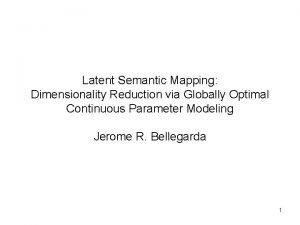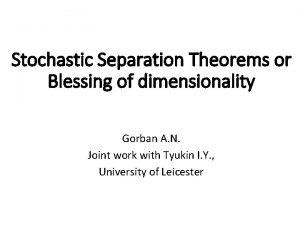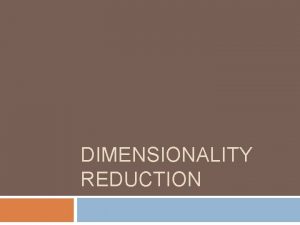Dimensionality reduction Usman Roshan Dimensionality reduction What is


































- Slides: 34

Dimensionality reduction Usman Roshan

Dimensionality reduction • What is dimensionality reduction? – Compress high dimensional data into lower dimensions • How do we achieve this? – PCA (unsupervised): We find a vector w of length 1 such that the variance of the projected data onto w is maximized. – Binary classification (supervised): Find a vector w that maximizes ratio (Fisher) or difference (MMC) of means and variances of the two classes.

Data projection

Data projection • Projection on x-axis

Data projection • Projection on y-axis

Mean and variance of data • Original data Projected data

Data projection • What is the mean and variance of projected data?

Data projection • What is the mean and variance here?

Data projection • Which line maximizes variance?

Data projection • Which line maximizes variance?

Principal component analysis • Find vector w of length 1 that maximizes variance of projected data

PCA optimization problem

PCA optimization problem

PCA solution • Using Lagrange multipliers we can show that w is given by the largest eigenvector of ∑. • With this we can compress all the vectors xi into w. Txi • Does this help? Before looking at examples, what if we want to compute a second projection u. Txi such that w. Tu=0 and u. Tu=1? • It turns out that u is given by the second largest eigenvector of ∑.

PCA space and runtime considerations • Depends on eigenvector computation • BLAS and LAPACK subroutines – Provides Basic Linear Algebra Subroutines. – Fast C and FORTRAN implementations. – Foundation for linear algebra routines in most contemporary software and programming languages. – Different subroutines for eigenvector computation available

PCA space and runtime considerations • Eigenvector computation requires quadratic space in number of columns • Poses a problem for high dimensional data • Instead we can use the Singular Value Decomposition

PCA via SVD • Every n by n symmetric matrix Σ has an eigenvector decomposition Σ=QDQT where D is a diagonal matrix containing eigenvalues of Σ and the columns of Q are the eigenvectors of Σ. • Every m by n matrix A has a singular value decomposition A=USVT where S is m by n matrix containing singular values of A, U is m by m containing left singular vectors (as columns), and V is n by n containing right singular vectors. Singular vectors are of length 1 and orthogonal to each other.

PCA via SVD • In PCA the matrix Σ=XXT is symmetric and so the eigenvectors are given by columns of Q in Σ=QDQT. • The data matrix X (mean subtracted) has the singular value decomposition X=USVT. • This gives – Σ = XXT = USVT(USVT)T – USVT(USVT)T= USVTVSUT – USVTVSUT = US 2 UT • Thus Σ = XXT = US 2 UT => XXTU = US 2 UTU = US 2 • This means the eigenvectors of Σ (principal components of X) are the columns of U and the eigenvalues are the diagonal entries of S 2.

PCA via SVD • And so an alternative way to compute PCA is to find the left singular values of X. • If we want just the first few principal components (instead of all cols) we can implement PCA in rows x cols space with BLAS and LAPACK libraries • Useful when dimensionality is very high at least in the order of 100 s of thousands.

PCA on genomic population data • 45 Japanese and 45 Han Chinese from the International Hap. Map Project • PCA applied on 1. 7 million SNPs Taken from “PCA-Correlated SNPs for Structure Identification in Worldwide Human Populations” by Paschou et. al. in PLo. S Genetics 2007

PCA on breast cancer data

PCA on climate simulation

PCA on QSAR

PCA on Ionosphere

Kernel PCA • Main idea of kernel version – – XXTw = λw XTXXTw = λXTw (XTX)XTw = λXTw is projection of data on the eigenvector w and also the eigenvector of XTX • This is also another way to compute projections in space quadratic in number of rows but only gives projections.

Kernel PCA • In feature space the mean is given by • Suppose for a moment that the data is mean subtracted in feature space. In other words mean is 0. Then the scatter matrix in feature space is given by

Kernel PCA • The eigenvectors of ΣΦ give us the PCA solution. But what if we only know the kernel matrix? • First we center the kernel matrix so that mean is 0 where j is a vector of 1’s. K = K

Kernel PCA • Recall from earlier – – XXTw = λw XTXXTw = λXTw (XTX)XTw = λXTw is projection of data on the eigenvector w and also the eigenvector of XTX – XTX is the linear kernel matrix • Same idea for kernel PCA • The projected solution is given by the eigenvectors of the centered kernel matrix.

Polynomial degree 2 kernel Breast cancer

Polynomial degree 2 kernel Climate

Polynomial degree 2 kernel Qsar

Polynomial degree 2 kernel Ionosphere

Random projections • What if we projected our data onto random vectors instead of PCA or LDA? • Turns out that random projections preserve distances upto a certain error

Johnson-Lindenstrauss lemma • Given any ε and n and k >= O(log(n)/ε 2), for any set of P of n points in Rd there exists a lower dimensional mapping f(x) (x in P) to Rk such that for any u, v in P • Furthermore, this mapping can be found in randomized polynomial time. Simply let each random vector be randomly sampled from thenormal Gaussian distribution. • Why does this work? Because random projections of vectors preserve length and we model distance between vectors u and v as vectors.
 Yann le cunn
Yann le cunn Usman roshan
Usman roshan Luxborg
Luxborg Usman roshan
Usman roshan Cs 675 njit
Cs 675 njit Usman roshan
Usman roshan Usman 136
Usman 136 Usman roshan
Usman roshan What this picture means
What this picture means Nlp dimensionality reduction
Nlp dimensionality reduction K ramachandra murthy
K ramachandra murthy Ml algorithm
Ml algorithm Types of attributes in data mining
Types of attributes in data mining Roshan dalvi
Roshan dalvi Roshan dalvi
Roshan dalvi Rohana roshan
Rohana roshan Roshan chitrakar
Roshan chitrakar Group
Group Dr usman shah
Dr usman shah Pengertian wawasan nusantara menurut prof wan usman
Pengertian wawasan nusantara menurut prof wan usman Nabila usman
Nabila usman Dr kauser usman
Dr kauser usman Dr kauser usman
Dr kauser usman Dr kauser usman clinic address
Dr kauser usman clinic address Usman mahboob
Usman mahboob Drg. usman sumantri m.sc
Drg. usman sumantri m.sc Dr kauser usman clinic address
Dr kauser usman clinic address Usman nawaz missing
Usman nawaz missing Doctor usman ghani
Doctor usman ghani Usman niazi nhs
Usman niazi nhs Dimensionality pronunciation
Dimensionality pronunciation Curse of dimensionality knn
Curse of dimensionality knn Dimensionality
Dimensionality Blessing of dimensionality
Blessing of dimensionality Electrochemistry ap chemistry
Electrochemistry ap chemistry




















































